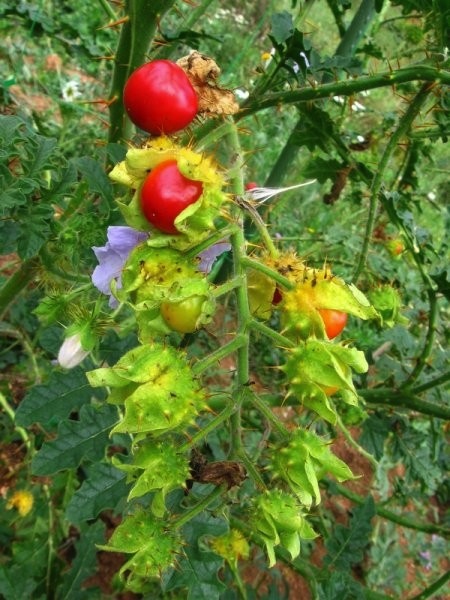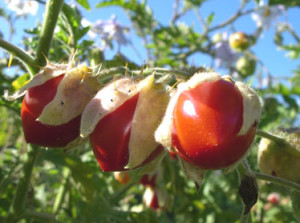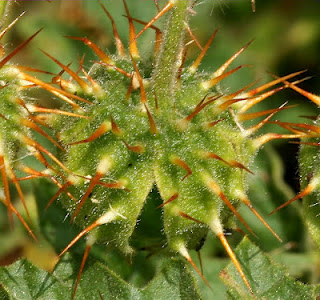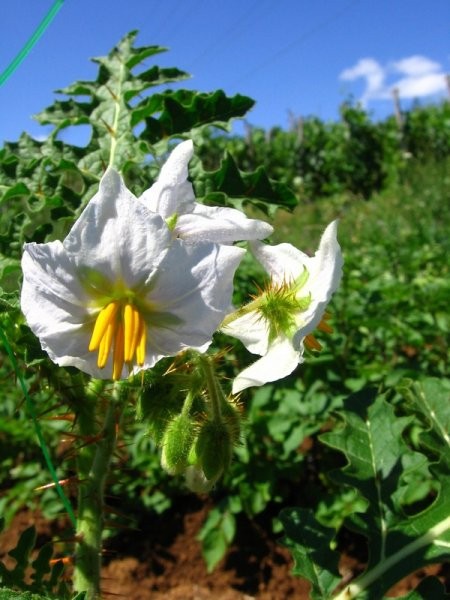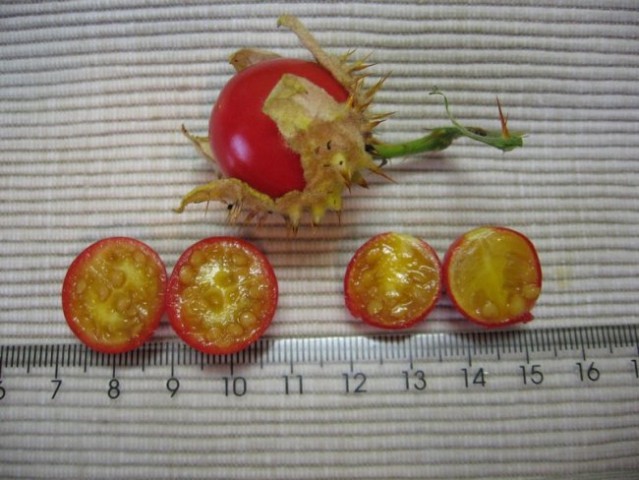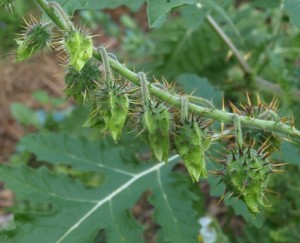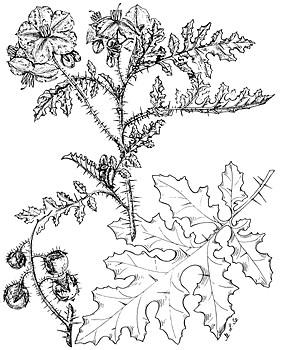Foraging is a treasure hunt because with perhaps 6,000 edible species in North America there is always a surprise now and then such as the Litchi Tomato.
Some people call it a wild tomato, others say it’s naturalized or an escaped crop. Some refer to it as an “heirloom.” Common names include Sticky Nightshade (not at all original) Morelle de Balbis, and Fire & Ice Plant (I have no idea why.) It can be found not only in gardens but in the wild around the world. A native of South America, particularly Paraguay, it’s a hardy nightshade that reseeds itself and gets along quite nicely without man’s attention. So even though you may cultivate it, the wandering botanical often strikes out on its own.
In North America its distribution is rather unconventional. Going around the rim states of the US it is found from Oregon south and east to West Virginia excluding New Mexico. Then it goes to the mid-Atlantic states skipping Maryland. It is also recorded in Massachusetts and Ontario. You will have to look at specific state maps to identify the counties the Litchi Tomato has been found it. A tough member of a fragile family it can take a light frost even temperatures down to 25F. In warmer climes it overwinters (and gets more spiny!) A bushy indeterminate, it does, however, need more than one plant to cross pollinated.
In its native South America the Litchi Tomato has been used in local dishes since before written records. And most unusual for this genus it has spines yet is still edible. Usually plants in this genus with spines are very toxic if not deadly. This is also why, particularly here in the southern United States, one must not mistake the Horsenettle — Solanum carolinense –for the Litchi Tomato. The results could be much illness if not death. Interestingly, since the Litchi Tomato does have spines (technically prickles*) it has also been use as a hedge around gardens, to keep animals out. It’s also a trap crop for potato cyst nematodes and has been in cultivation in Europe since the 1700s. The plant, however, is banned in South Africa. In Australia it is found in New South Wales, Queensland, Western Victoria and possibly Victoria.
The fruit develops in a husk (calyx) that is totally covered with spines (unlike the Horsenettle which has spines but no husk.) Then the husk, which is slightly bullet shape, folds back to reveal a bright red cherry-tomato like fruit. Interior flesh is yellow and seeds resemble cherry tomato seeds. Its texture is similar to a raspberry and the taste is tart like a sour cherry. The fruit is ripe when it can be removed easily. If it resists it is not ready to eat.
In small amounts the dried roots, with that basal part of the stem, were used as a diuretic to treat kidney issues and high blood pressure. The roots were also chewed to induce abortions. See Herb Blurb below.
As for the botanical name this is going to be a little confusing. Part of its name is easy and part difficult. Solanum (so-LAY-num) is the easy part and means sun. Sisymbriifolium ( sis-sim-bree-ee-FOL-lee-um) is more convoluted. Sisymbrium is from the Greek sisumbrion (??????????) and means sweet-smelling plant. It’s what Greeks called the bergamot mint. A Tumbleweed Mustard, which is not sweet smelling at all, was named Sisymbrium because the mustard leaves looked similar to the bergamot’s leaves. The Litchi Tomato’s leaves look similar to the Tumbleweed Mustard so it was called Sisymbriifolium, meaning leaves that look like the mustard that look like the bergamot … And botanists think they really make it clear and easy for us mere foraging mortals.
Other common names include: Alco-Chileo (Spanish), arrabenta cavalo, dense-thorn bitter apple (English), doringtamatie (Afrikaans-South Africa), espina colorada (Spanish), fire and ice plant (English), jeweelie (Argentina), joão bravo, jua das queimadas (Portuguese), jua de roca (Portuguese), klebriger nachtschatten (German), litchi tomato (English), liuskakoiso (English), manacader, morelle de balbis (French), mullaca espinudo, ocote mullaca (Spanish), pilkalapis baklazanas (Lithuanian), puca-puca (Spanish), raukenblatt-nachtschatten (Austria), red buffalo-burr (British Isles), revienta caballo (Spanish), sticky nightshade (English-United States, United Kingdom), tomatillo (Spanish), tutia (Spanish), tutia o Espina Colorada, uvilla, viscid nightshade (English-United States, Australia), wild tomato (English), wildetamatie (Afrikaans-South Africa.)
World wide, it is reported in: Australia, Austria, Belgium, Canada, China, Congo Republic, Czech Republic, Denmark, Finland, France, Germany, Hungary, India, Ireland, Italy, Japan, North and South Korea, Latvia, Lithuania, Mexico, Netherlands, New Zealand, South Africa, Spain, Swaziland, Sweden, Taiwan, Turkey, United Kingdom, and the United States.
*Prickles are outgrowths of the epidermis and not modified branches, which are spines.
Green Deane’s ITEMIZED Plant Profile: Litchi Tomato
IDENTIFICATION: Solanum sisymbriifolium is an annual or perennial erect to about a yard to one meter in height. The stem and branches are sticky, hairy, and armed with flat, yellow-orange spines up to half inch (15mm) in length. The oval to lance shaped thorny leaves have stems a half inch to two inches long (1-6cm) and are hairy above and below with stellate and glandular hairs. The leaves are pinnately divided into four to six coarse lobes and may be up to 15 inches long (40cm) and half as wide. Flowers emerge from the foliage and are internodal, unbranched racemes composed of one to ten perfect (staminate) flowers. The five-parted flowers are white, light blue, or mauve, about an inch (3cm) in diameter, and have a hairy calyx a quarter of an inch (5-6 mm) long. They smell like fish. The fruit is a red, succulent, globular berry from a half inch to an inch (12-20 mm) in diameter with pale yellow seeds.
TIME OF YEAR: Similar to tomatoes depending on the climate.
ENVIRONMENT: Similar to a tomato, rich soil, ample sun, moderate, steady watering. Treat them like a tomato except set them out a bit later when its warmer. In exchange they fruit a little longer. The Litchi Tomato is found along roadsides, waste places, landfills, and disturbed fields. A good place to look in farming country in around manure piles or compost bins. In Australia it likes eucalyptic woodlands
METHOD OF USE: Like tomatoes. A healthy plant will produce about a quart of fruit each. Some folks like to put them thought a sieve to remove the seeds. From a culinary point of view they respond well to some sweetness which then gives them a sweet and sour appeal. Surprisingly I could not find the plant mentioned in Cornucopia II, which is kind of the forager’s Bible for edible plants around the world.
Seed source: $3 at Baker Creek Heirloom Seeds.
Hot and Spicy Litchi Tomato Chutney: Recipe from Mother Earth News
Four cups green tomatoes, sliced into small shreds, measure after slicing; ? 2 1?2 cups whole Litchi tomatoes, hulls removed; ? 6 dates, seeded and coarsely chopped; ?4 garlic cloves, each sliced into 4 pieces ?lengthwise; ?zest of 2 limes; ?1 tbsp or more hot pepper, finely minced; ?1/2 cup white vinegar; ?2 tsp mustard seed, crushed to meal-like consistency; ?1 tsp fennel seed, preferably Indian Lucknow fennel; ?1/2 tsp ground cinnamon; ?1 tsp cumin seed?; 1 cup green raisins; ?1 cup chopped mango or under-ripe peach; ?1 cup slivered almonds; ?2 1?2 cups honey or 3 cups sugar.
Combine all ingredients in a deep pan and cook over medium-high heat for 20 minutes, or until thick. Remove from the heat and lift out the fruit mixture with a slotted spoon and put it into hot, sanitized preserve jars standing in hot water. Reduce the remaining syrup over high heat until thick like honey, and then pour this over the hot fruit and seal. Allow to mellow two weeks before using. Yields approximately four 12-ounce jars.
Herb Blurb
J Ethnopharmacol. 2000 Jun;70(3):301-7.
Isolation of hypotensive compounds from Solanum sisymbriifolium Lam.
lbarrola DA, Hellión-lbarrola MC, Montalbetti Y, Heinichen O, Alvarenga N, Figueredo A, Ferro EA.
Source
Pharmacology Department, Faculty of Chemical Sciences, National University of Asuncion, PO Box 1055, Asuncion, Paraguay.
Abstract
The crude hydroalcoholic root extract (CRE) of Solanum sisymbriifolium Lam. has formerly been shown to have hypotensive activity both in normo-and hypertensive rats. Hypotensive activity-guided fractionation of the CRE was performed in anaesthetized normotensive rats, which led to the isolation of the active principles. The intravenous (i.v.) and intraperitoneal (i.p.) values of the CRE in mice were found to be, respectively, 343 and 451 mg/kg, and no lethal effect was caused by doses up to 5.0 g/kg when administered by oral route. Depression of locomotion, increase of breathing rate and piloerection was observed in a general behavior test with doses up to 200 mg/kg i.p., and 1000 mg/kg p.o., respectively. Increase in the gastrointestinal transit was found using 0.1 g/kg, whereas at doses of 0.5 and 1 g/kg, no significant activity was observed in comparison with the control mice. Hexanic and butanolic fractions induced a remarkable hypotension in anaesthetized normotensive rats in doses of 1, 5, 7.5 and 10 mg/kg i. v. Two compounds isolated from the butanolic fraction induced a significant decrease of the blood pressure, HR, amplitude of the ECG and breathing rate when injected in a dose of 1 mg/kg i.v; and both systofic and diastolic, blood pressures were affected in a proportional mode. The hypotensive effect of the two compounds were not influenced by pretreatment with atropine and propranolol; and the pressor response to noradrenaline was not affected by any of them which suggests that neither a direct muscarinic activity, beta-adrenoceptor activation nor decrease of sympathetic vascular tone (sympatholitic activity) are probably involved in the mechanism of hypotension. The present study shows that the CRE of S. sisymbriifolium contains at least two hypotensive compounds whose characterization is under way.
PMID:
10837991
[PubMed – indexed for MEDLINE]
Hypotensive effect of crude root extract of Solanum sisymbriifolium (Solanaceae) in normo- and hypertensive rats.
Source
Research Department, Faculty of Chemical Sciences, National University of Asuncion, Paraguay.
Abstract
The hypotensive effect of the crude hydroalcoholic extract from root of Solanum sisymbriifolium Lam. (Solanaceae) was investigated both in normotensive and hypertensive rats. The intravenous administration of the extract (50 and 100 mg/kg) produced a significant decrease in blood pressure in anaesthetized hypertensive (adrenal regeneration hypertension + deoxycorticosterone acetate (ARH + DOCA)) rats. Oral administration of the extract (10, 50, 100 and 250 mg/kg) also produced a dose-dependent hypotensive effect in conscious hypertensive animals. In anaesthetized normotensive rats, the extract (50 and 100 mg/kg, i.v.) also induced hypotension in a dose-dependent manner. Lastly, no significant effect on blood pressure was produced by the extract when administered orally (10, 50, 100, 250, 500 and 1000 mg/kg) to conscious normotensive rats.
- PMID:
- 8941862
- [PubMed – indexed for MEDLINE]

